

Money Madness by D. H. Lawrence – Summary, Analysis and Solved Questions
Table of Contents
Money Madness by D. H. Lawrence
About the Poem
As the title implies, the poem is about financial insanity. The poet expresses concern about man’s desire for more wealth and luxuries, as well as the erosion of human values. Money madness dehumanises man. If money madness is not reined in, it has the potential to destroy our humanity. Money is the source of our collective insanity. Individuals cannot protect themselves from it.
Please enable JavaScript

Man spends money with trepidation and pang. Money causes us to flee. Money has brought us to our knees. Money wields a terrifyingly cruel power over men. We are terrified of humanity’s collective insanity. If the man is without money, he will have to eat dirt and succumb to the elements. They will not provide him with enough bread. The world will decide whether he lives or dies. Man is afraid of eating dirt, which is why he must save money. We must exercise caution in our dealings with money. Man will be fearless if he has access to free bread, shelter, and fire. If this is not done, mankind will begin to murder one another.
Summary of Money Madness
Money Madness is written by D.H. Lawrence. In this poem, the poet exposes the craziness of money-hungry humans. The poet condemns the madness for money, claiming that it has resulted in the loss of life’s values. D.H.Lawrence’s poems, such as ‘Snake’ and ‘Mosquito’, are primarily an examination of interpersonal, man-animal relationships. The poem decries man’s insatiable desire for wealth and worldly luxuries at the expense of human values. Man becomes an insensitive and inhuman being as a result of this madness. He loses his spirituality, his faith, his sympathy, and his morality. If left unchecked, this madness has the potential to destroy our humanity.
Money insanity is more perilous than money. It has conditioned man to humiliate those without money. Individuals who lack financial resources are fearful of social humiliation. Man’s worth is quantifiable in monetary terms. This fear results in an emotional outburst. Man is more concerned with his self-esteem. As a result, he desires money.
The poet expresses opposition to this attitude. He asserts that this is all incorrect. He is adamant that everyone should receive free bread and shelter on a global scale. According to the poet, we should exchange wisdom for money. Unless and until we do this, men will continue to murder others for money. Thus, he criticises money-madness for resulting in the loss of life’s values.
Analysis of the Poem
In the poem ‘Money Madness,’ the poet observes his fellow human beings from a materialistic perspective. The poet is fearful of a future in which humans become inhuman in their pursuit of money. D.H Lawrence’s Money Madness is a satirical examination of the rush for affluence that is visible all around us in today’s world. Money has become a significant player in contemporary societies and is central to the modern way of life. The poet has attempted to exemplify this situation and depict the social and moral degradation through his pen. The poet asserts that madness for money exists everywhere; indeed, money can be used as a metaphor for the term madness. And this madness is not on a micro or individualistic scale; it is the madness of the multitude, in unfathomable numbers and at incredible scales.
Each person in this world carries a portion of this insanity. The poet expresses doubt that there is a human being in this world who can hand out a pound note without feeling a pang of guilt. No matter how noble he feels while handing out the note, his heart always wishes he could do all that good without ever having to take a note from his pocket.
The primary reason for unhappiness and suffering is that we have paid and continue to pay more attention to material progress and comforts while ignoring life-sustaining human values. Without a doubt, science and technology have advanced tremendously, but we continue to lag behind in our understanding of ourselves and our fellow beings. We are more concerned with lust, power, and wealth than with human empathy, comprehension, affection, kindness, and cooperation. Self-centred attitudes ultimately result in self-destruction. Without regaining our sanity, we will undoubtedly create a chaotic society.
Questions and Answers
1. Why does the poet state that money is our collective madness? Ans:- The poet states that money is our “collective madness” as he deals with a topic of universal importance regarding the money madness of man. This madness is not on small or individualistic level but it is the madness of the multitude. 2. Why do we grovel before money? Ans:- We grovel before money as it has become the controlling power of our lives. It makes us kneel infront of itself. It makes us fearful and a sense of apprehension and stress grips us. It has an exaggerating power to influence our life. 3. What does the poet mean by, ‘I shall have to eat dirt’? Ans:- The poet says that if he has no money, the world would give him “little bread” to eat, in the name of humanity. But even this small offering does not come for free. He has to suffer through pains unheard and criticisms unparallelled. This is what the poet means when he says “I shall have to eat dirt”. 4. What is the poet afraid of? Ans:- The poet is afraid of the inhumane and pitiful situation of eating dirt if one has no money. He fears that such madness for money might result in the world going completely insane. 5. Do you agree with the poet that our basic needs should be free? Ans:- Yes, our basic needs such as bread, shelter and fire should be free to people all around the world. It is the cost of these basic needs that make man rush for money and once these needs are made free, man would regain his sanity about money. Critically Analyze 1. Money is our madness, our vast collective madness. And of course, if the multitude is mad The individual carries his own grain of insanity around with him. a. Why is money referred to as our collective madness? Ans:- Money is referred to as our collective madness as this madness is not on small or individualistic levels but it is the madness of the multitude, in numbers unimaginable and at levels incredible. And since the multitude as a whole is mad, so every person in this world carries his share of “insanity” with him. b. Is it the craving for money by each individual that goes on to make up this collective madness? Ans:- Yes, it is the craving for money by each individual that goes on to make up this “collective madness”. 2. It is that I am afraid of. And that fear can become a delirium. It is fear of my money mad fellow-man. We must have some money To save us from eating dirt a. What is the poet afraid of? Ans:- The poet is afraid of the inhumane and pitiful situation of eating “dirt” if one has no money. He fears that such madness for money might result in the world going completely insane. b. What would money save us from? Ans:- Money would save us from the inhumane and pitiful situation of eating “dirt”. c. What is the dirt that the poet is referring to? Ans:- The untold sufferings, pains unheard and criticisms unparalleled that one has to go through when he has no money, is the “dirt” that the poet is referring to.
Detailed Questions 1. How does money have a cruel power over men? OR
Discuss the theme of the poem Money Madness. Ans:- D.H. Lawrence’s poem “Money Madness” is a critical examination of the modern era’s frenzy for money. Money has become a powerful force in today’s societies, and it now has a greater importance in people’s lives than anything else. The poet’s poem attempts to exemplify this situation and to depict the social and moral degeneration that such madness for a materialistic object results in. Wealth and money are such seductive forces that we are unable to control them; rather, they control us. Thus, the poet describes how wealth inverts control, saying, “It has brought us low, and we grovel before it in strange terror.” The poet questions whether there is a human being in this world who can hand out a one-pound note without feeling a pang of guilt. No matter how noble he feels while handing over that note, his heart always wishes he could do all good without ever having to remove a note from his pocket. And when it becomes a ten-pound note, we feel a genuine tremor within. The greater the sum, the more difficult it is to give it away. Often, society judges a man solely on the basis of his wealth. If he is impoverished, society says, “Let him eat dirt and die of exposure.” Thus, money wields a cruel power over men by compelling us to kneel in front of it and also by exaggerating its ability to influence our lives. 2. How does the poet make a distinction between money and money-madness? Ans:- According to the poet, everywhere we look, there is madness for money. Indeed, money can be thought of as a metaphor for the term “craziness.” This is not a case of small or individualistic madness, but of “multitude” madness. In a broader sense, the poet asserts that we are terrified of mankind’s insanity for money, not money itself. He distinguished between money and money-madness in the poem with the lines, “But it is not money that we fear; it is mankind’s collective money-madness.” Money should not be blamed for mankind’s insanity; rather, it is the madness associated with it that degrades man’s moral values. The human race has succumbed to madness as a result of the money craze. Anguished by it, the poet opines that we should cure ourselves of “money madness” rather than “money,” and that unless we “restore our sanity” regarding money, man will revert to animal status. We’re going to start murdering one another for the sake of profit. 3. How do you think people can overcome ‘money-madness’? Ans:- People can overcome “money-madness” if bread, shelter, and fire are made universally available to everyone, everywhere. This is because we all struggle to earn a living, and it is the cost of these basic necessities that drives man’s desire for additional money. The cost of such things is what impoverishes man. Once man’s basic needs are met, he will regain his financial sanity. The abolition of materialistic goods with a price component would assist people in overcoming “money madness.”
Discover more from Smart English Notes
Subscribe now to keep reading and get access to the full archive.
Type your email…
Continue reading


Money Madness by D. H. Lawrence
“Money Madness” appears in D. H. Lawrence’s posthumous poetry collection The Ship of Death and Other Poems . This poem is about the greed of humankind for money, wealth, and possessions. Lawrence chiefly centers his thoughts on people’s overt materialism. In this modern world, money has become a parameter to judge one’s worth. It does not matter whether there are any columns of essential elements of goodness or not. People do check how much one has. If he has a meager amount with him, they even make him grovel and eat dirt.
- Read the full text of “Money Madness” below:
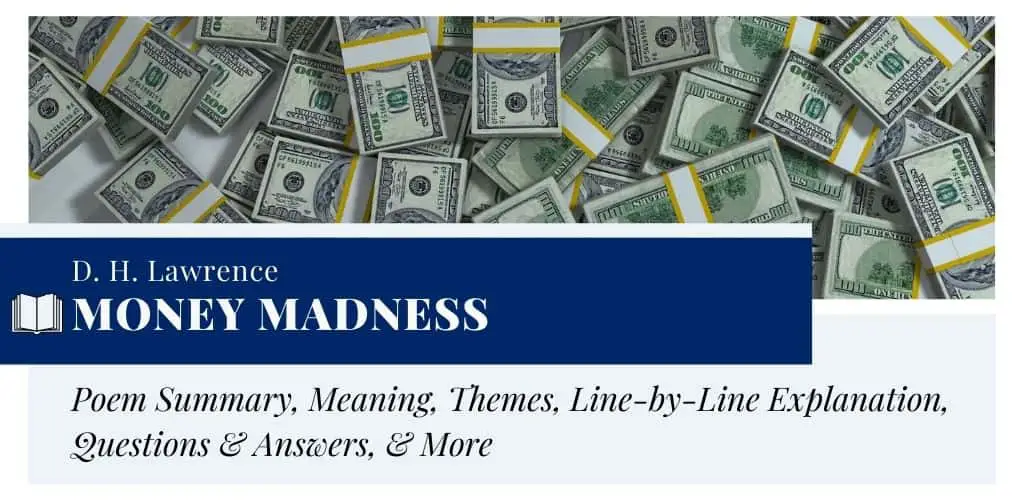
“Money Madness” is all about people’s insanity over money in this materialistic world. Their thoughts are only filled with the crisp notes and jingles of coins. According to the poet, the multitude is mad and an individual has their fair share of insanity with him. People hesitate while sharing a little. The poet describes how money makes them slaves and afraid of losing their possessions. He is of the view that “money-madness” is more frightening than the cause. They don’t care to enslave the penniless fellows. The poor ones are even made to eat dirt. At last, the poet in a vexed tone says that the essential things for survival should be free. Otherwise, this madness must lead humankind to ruthlessly kill each other.
The title of the poem “Money Madness” gives readers an explicit hint at the central idea. It is about the insane behavior of men concerning money. According to the poet, money is not a problem in itself. But, the wildness originating from a greedy heart, is the source of all the problems occurring across the world. Besides, through this poem, Lawrence also taps on the lack of compassion and sympathy in modern beings. They judge others’ worth by their material possessions. Lawrence is out of the money-mad critic’s eyes. If he has nothing to spend, people even make him eat dirt and go cold in life’s winter. Sometimes, they provide a meager amount of help associated with an air of supremacy. In this way, Lawrence describes the concept of “money-madness”.
Structure & Form
This poem consists of thirty lines separated into a number of stanzas. Some stanzas contain only one line. In other stanzas, the line count ranges from two to five. There is not a specific rhyme scheme or meter in the poem. So, it is in the free-verse. Besides, the poet speaks in this piece from the first-person point of view. So, it is also an example of a lyric poem. However, the musicality of conventional lyrics is not present in this piece. The lines are prosaic in structure. To create internal rhyming, Lawrence makes use of repetition of words or similar sounds within a line. Apart from that, he concludes the sense of each section by using end-stopped lines.
Poetic Devices
Lawrence uses the following poetic devices in “Money Madness”.
- Enjambment: It occurs throughout the poem. For example, the second and third lines are enjambed.
- Repetition: In this poem, Lawrence uses the repetition of “money” and “madness” a number of times. He also uses this device to create an artistic effect. For example, the repetition of “that” in “It is that that I am frightened of” depicts the fearful mental state of the speaker.
- Irony: The poet uses this device in the very first line “Money is our madness, our vast collective madness”. It also occurs in the following lines.
- Sarcasm: It occurs in the second and third lines. Here, the poet humorously describes people’s attachment to money.
- Personification: In the line “for money has a fearful cruel power among men”, Lawrence personifies the inanimate object, “money”.
- Metaphor: In “Then let him eat dirt, and go cold”, “dirt” is used as a metaphor of denigration and belittling someone.
- Alliteration: It occurs in “ m ultitude is m ad”, “ m oney- m adness”, “ m y m oney- m ad fellow- m en”, etc.
Lawrence’s poem “Money Madness” explores the theme of money and other themes associated with this concept. These include materialism, fear and apprehension, cruelty, and lack of compassion. The main theme of this poem centers on the lust for money. Lawrence describes what human beings are up to for it. It has turned into a precious thing for a living. Hence, people have become ruthless in protecting their wealth. The poet thinks that the money-madness of humankind is the root cause of all the evils. Besides, he also showcases the cruel treatment towards the poor fellows and the fear of having no money in this poem.
Line-by-Line Critical Analysis & Explanation
Money is our madness, our vast collective madness. And of course, if the multitude is mad the individual carries his own grain of insanity around with him. I doubt if any man living hands out a pound note with-out a pang; and a real tremor, if he hands out a ten-pound note.
The poem “Money Madness” begins with an ironic statement. Lawrence describes money as a vast and collective ailment of mankind. It is not limited to an individual. Rather, it has become gout in the legs of humanity. In the following lines, the speaker says that this madness differs from person to person. Each person has his unique share of madness. Though the root cause of this problem is money, its manifestation is different.
The speaker doubts if any man living in this materialistic world holds out a pound without a pang in his heart. By using the expression “pound note with-out a pang”, the poet invests this line with sarcasm. Besides, readers can find an internal rhyming of the “p” sound here. In the next line, the poet humorously says that if a person holds out a ten-pound note, it is a moment of “real tremor” for him. Through these lines, Lawrence describes one facade of this money-madness. It deals with the selfishness of humankind.
We quail, money makes us quail. It has got us down, we grovel before it in strange terror. And no wonder, for money has a fearful cruel power among men. But it is not money we are so terrified of, it is the collective money-madness of mankind. For mankind says with one voice: How much is he worth? Has he no money? Then let him eat dirt, and go cold.–
In the following lines, Lawrence reveals another symptom of insanity. It deals with the idea of enslavement. According to the poet, money makes us all fearful. It enslaves our minds that are filled with greed. Like slaves were drawn to the ground and tortured, the rich do the same with the poor fellows.
The poet personifies money as a slaver or master. It enslaves people and gets them down on their knees. Then, it makes them grovel before it, in a “strange tremor”. Through this image, the poet conveys the helpless submission of men to money.
Besides, he invests money with a “fearful cruel power”. Money in itself is worthless. It is people’s perception that makes some notes look precious. When a person gets involved with a thing so deeply, it naturally makes them fearful of losing it. Through these lines, Lawrence is referring to this apprehension.
Furthermore, the poet says that money is not the cause of his apprehension. Rather it is madness associated with it that the poet is afraid of. Why does he fear this insanity so much? It is because of the behavior of the money-mad men. They judge others by their monetary worth. If one has nothing, they do not hesitate to leave them in suffering. The cruel treatment towards them is compared to eating dirt or going cold in life’s winter.
Lines 13-20
And if I have no money, they will give me a little bread so I do not die, but they will make me eat dirt with it. I shall have to eat dirt, I shall have to eat dirt if I have no money. It is that that I am frightened of. And that fear can become a delirium. It is fear of my money-mad fellow-men.
There is no difference in the speaker’s case. If he is penniless, people won’t think twice before condemning him. He thinks he will be given a little bread as he does not die. If he dies soon, how can they take sadistic pleasure from his suffering? Hence, the poet says they show their apparent humane selves in order to make him enslaved to their power of money.
Then, they will make him eat dirt along with the bread. The help they provide to the speaker is a form of business. They try to purchase one’s self-worth with a bit of financial assistance. However, from the poet’s tone, it is clear that he is afraid of such a senseless bargain. He does not want to sell himself to anyone if he has no money. It is the fear of submitting oneself to the rich that makes the poet apprehensive. By the repetition of “I shall have to eat dirt” the poet reflects his tensed mental state.
In the following line, Lawrence reiterates this idea and says that he is fearful of it. According to him, this fear can become a delirium. So, the fear of the “money-mad fellow men” can cause a long-lasting mental disorder in others.
Lines 21-30
We must have some money to save us from eating dirt. And this is all wrong. Bread should be free, shelter should be free, fire should be free to all and anybody, all and anybody, all over the world. We must regain our sanity about money before we start killing one another about it. It’s one thing or the other.
In the first lines of this section, Lawrence ironically talks about the role of money in his life. It is nothing but a type of protection against condemnation. In the long run, it would save people from eating dirt. What human beings are up to is wrong. The poet did not expect this.
He is of the view that all the basic needs for survival should be free to everybody. These include food, shelter, and fire. Lawrence uses the repetition of the phrase “all and anybody” for the sake of emphasis.
The last three lines of the poem contain another important idea. Here, the poet speaks about the ruthlessness of humankind. According to him, people must regain their senses before they start killing each other for money. It is not limited to this only. There are several tragic consequences of “money-madness”.
Historical Context
The poem “Money Madness” was first published in D. H. Lawrence’s poetry collection The Ship of Death and Other Poems . It was posthumously published in 1932. This poem was written in the 1920s, a few years before Lawrence’s death. In that phase, he mainly wrote poems revealing the cruelty, inhumanity, and brutality of humankind. His pessimism concerning the modern world is reflected in his post-World War verses. In “Money Madness”, he chiefly describes the mindset of materialistic humans. He reveals how they adore money. They can go far below their standards for it. Besides, he also reveals the implications of this insanity for money.
Questions & Answers
The poet points out the peculiar actions human beings take in order to fulfill their hunger for money. Not only that, they devalue others for not having money. In this poem, he shows their peculiar reaction while handing over money to others. So, the possession of money makes them do absurd things as lunatics.
Indeed, money makes us feel better. But, it is a short-term solution to a major problem, unhappiness. To be happy, one needs to improve one’s internal state. External developments are transient. While inward developments help one to find fulfillment in life. Money has no role in this inward development of mankind.
The term “Money Madness” is an ironic reference to the greed of human beings for money. It is compared to a mental disorder. People do senseless things and react irrationally. Hence, Larence describes this peculiarity as insanity.
Through this poem, the poet advises us to regain our sanity. Otherwise, the madness for money can lead human beings to kill each other without a justifiable cause.
The poet is more afraid of the “money-madness of mankind” than money itself.
In this poem, the poet opines that human beings must regain their sanity in order to restrain them from killing each other.
People can overcome the craze for money by self-interrogation. They have to ask themselves what is the real worth of money. It is just a means for survival, not a cause of fulfillment. In the materialistic world, they are controlled by money. To regain their sanity, they have to be the masters of money, not slaves.
When the multitude goes money-mad, they react irrationally for the fear of losing money. They judge others’ worth by their wealth and treat them inhumanely.
The poet repeats the phrase “all and anybody” for emphasizing the fact that the basic needs for survival should be free to everyone living across the world.
When one gets too attached to money, it makes them fearful of losing it. This possessiveness is the root cause of their insecurity.
The term “collective” hints at the fact that “money-madness” is not a problem for a few of us. In this materialistic world, it has become a universal ailment. The difference lies in its manifestation in each individual.
We must regain their sanity about money to stop them from causing irrevocable harm to humanity.
Through this line, Lawrence hints at the inhumane treatment one gets from society if he has no money.
According to the poet, if one has no money, he is treated with contempt and indignation. The way of weighing one’s worth by money is wrong.
Through this phrase, the poet describes the universality of the concept of “money-madness”. There are not a few but most of us are mad about money.
To regain sanity means to be sensible and rational.
The “strange terror” of money is associated with our fear of losing it.
The poet says so to hint at the fact that it does not matter what one had. People judge one’s worth with money. If the poet does not have any, he will face indignation like others.
Money invests rich with the “cruel power” and makes them the unofficial rulers of the world. In this materialistic society, the rich have the power to treat the poor inhumanely.
According to the poet, if money is a parameter to judge one’s worth, he will be weighed by his wealth. If he has no money, he must face inhumane treatments. It seems as if they are slaves to wealthy people.
By this line, the poet describes how humans have gone below the humane standards for money. Their attitude shows to what extent their minds have gone down for it.
Similar Poems about Materialism
- “The Toys” by Coventry Patmore — This poem hints at worldly toys such as money in order to describe our childish attachment with them.
- “The Vagabond” by Robert Louis Stevenson — In this poem, the speaker wishes to be free from the clutches of the materialistic world.
- “To a Poor Old Woman” by William Carlos Wiliams — This piece describes how a poor woman finds pleasure in the ripe plums.
- “Dawn at Puri” by Jayanta Mahapatra — In this poem, Mahapatra taps on the themes of human suffering and hunger.
External Resources
- Lecture on “Money Madness” — Listen to this informative lecture on Lawrence’s poem.
- About D. H. Lawrence — Learn about the poet’s life and explore his best-known poems.
- A New Life of D. H. Lawrence — Read more about the poet’s life and an overview of his works.
- Poet Profile & Poems of D. H. Lawrence — Explore the poet’s profile and read more of his poems.
Share this:
At Poemotopia, we try to provide the best content that you can ever find. Each article is the fruit of a rigorous editorial process.
Similar Posts
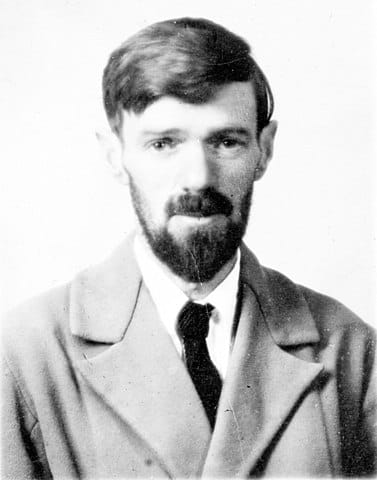
10 Best Poems of D. H. Lawrence
Here we are going to talk about the 10 best poems of D. H. Lawrence that riveted his name in the literary history of the 19th century.
that was nice explanation of the poem. and the way of your work is amazing.
Really inspiring! Thanks. Don’t forget to explore 10 of the best poems of D. H. Lawrence.
Leave a Reply Cancel reply
Your email address will not be published. Required fields are marked *
Save my name, email, and website in this browser for the next time I comment.
Notify me of follow-up comments by email.
Notify me of new posts by email.


Money Madness Poem Class 11 Summary & Line by Line Explanation in English
Back to: Karnataka Board Class 11th English Guide and Notes
The poem Money Madness is a stinging exposition of the modern consumerist world that is based on material wealth and money. People today are so invested in the race to aggregate money that they are willing to sacrifice their morals and even sanity.
The poet labels money and the greed for it as our own form of madness that is ruining us as a society. The whole world being money-mad is a sum of individual people who in turn are turning insanely money-oriented. Each individual episode of insanity makes the whole world a maze of lust for money.
He laments that people are so afraid to lose whatever money they have that they find it hard to spend charitably. Even if it is one pound, we feel devastated to lose it.
A sum as high as 10 pound actually makes people shake with anxiety and sadness. We have become enslaved to the chains of money power. It makes us prostrate and worship it. It controls our thoughts and influences our actions.
The poet goes on to claim that there is something even more powerful that is at work in this whole race for money. It is the kind of social status and sanction that we as a society offer to people with money and people without it.
Money has become the single biggest marker and signifier of worth and importance in society. When we evaluate a person today we hardly notice his/her values and characteristics. We only judge his material possession and wealth.
If he suffers from deprivation and poverty, then he is condemned as weak, unfit and liable to suffer. He has to struggle, scrap and suffer pains just because he is poor. Even his death becomes insignificant because he lived a poor man.
People may spend enough to buy him some food but only enough to survive and suffer more. This insane worship of money is becoming a form of delirium that we as a species are suffering with. The poet decries such apathy that people have for the poor.
He believes that every person, irrespective of his condition, has the right to food, home, warmth and freedom. Until that happens we will continue to be puppets in the hands of money and material things. We will continue to attaché value to competition and race for more wealth.
Ultimately this will cause the whole world to burn with enmity, hatred, jealously and insanity. It will continue to cause more human suffering and deaths. We have to choose; either human survival or eventual ruin.
Play Quiz on Money Madness

Search This Blog
OOLTA SOCH is a dedicated website for educational purpose. Our site comprises a number of analyses with question answer descriptions. You will get few of the success stories in the different sectors along with current affair hit topics. Subscribe our Youtube channel www.youtube.com/ooltasoch
MONEY MADNESS by D.H. Lawrence (Analysis and Question Answer Discussion)
Money madness , d.h. lawrence, introducing the poet, the text , video description in odia.
Think it out

Very nice👍👍👍👍👍👍👍😊😊😊😊😊
Woori Casino Login - Play on Mobile or Desktop The Woori 우리카지노octcasino Casino App will be available at Woori Casino on a mobile or desktop aprcasino.com basis. To play on our mobile casinosites.one or desktop, septcasino you can also play with your https://www.communitykhabar.com desktop browser,
Very good website
Post a Comment
Popular posts, on examination by winston 's churchill q & a for +2 chse students.
Daffodils by William Wordsworth (With Question Answers) CHSE Invitation to English I Book
After Twenty Years by O’ Henry Question and Answers
To my True Friend by Elizabeth Pinard Explanation and Question Answers
The Doctor's Word by R. K. Narayan Questions and Ansewers
The Inchcape Rock Question Answers
In London in minus four by Louis Fischer (Questions and Answers)
My Greatest Olympic Prize by Jesse Owens
THE BALLAD OF FATHER GILLIGAN

Money Madness Summary
D.H. Lawrence’s short story, “Money Madness,” explores the destructive power of greed and the pursuit of wealth. Written in the early twentieth century, the story delves into the psychological and emotional consequences of an insatiable desire for money. This article will provide a comprehensive guide on how to write an effective summary of “Money Madness,” highlighting its key elements and capturing the essence of Lawrence’s critique on the corrosive nature of materialism.
Table of Contents
Crafting an Effective Summary
Writing a summary of “Money Madness” requires a thorough understanding of the story’s plot, themes, and the critique of materialism presented by D.H. Lawrence. Follow these steps to craft an effective summary that captures the essence of the story:
Read and Understand the Story: Begin by reading the story attentively, gaining a comprehensive understanding of the characters, plot, and underlying themes. Pay close attention to the transformation of the protagonist, Paul, and the portrayal of the destructive nature of greed.
Identify the Central Theme: The central theme of “Money Madness” is the detrimental effects of materialism and the pursuit of wealth. Highlight this theme in your summary and ensure that it remains the focus throughout.
Concise Introduction: In the introductory paragraph of your summary, briefly introduce the story, its author (D.H. Lawrence), and mention the central theme you identified.
Summary of the Content: Summarize the story’s content, beginning with the portrayal of Paul as a contented worker who becomes consumed by the desire for wealth. Describe his gradual transformation and the detrimental impact of his obsession on his relationships and personal well-being. Emphasize the emptiness and disillusionment that Paul experiences despite his accumulation of wealth.
Key Characters and Relationships: Highlight the significance of the supporting characters and their relationships with Paul. Discuss how his pursuit of money leads to the deterioration of his connections with family and friends. Explore the theme of alienation and the toll it takes on Paul’s emotional and psychological state.
Critique of Materialism: Discuss Lawrence’s critique of materialism and consumer culture. Analyze how the story exposes the hollowness of equating personal worth with financial success. Explore the notion that true happiness and fulfillment cannot be achieved through the acquisition of material possessions alone.
Symbolism and Imagery: Comment on the symbolism and imagery employed by Lawrence to reinforce the story’s themes. Discuss how he uses objects and settings to depict the allure and ultimate emptiness of material wealth.
Resolution and Conclusion: Describe the resolution of the story, where Paul confronts the futility of his pursuits and the destructive consequences of his obsession. Reflect on the lasting message of “Money Madness,” emphasizing the need for a balanced perspective on wealth and the importance of prioritizing meaningful relationships and personal well-being.
Money Madness Summary Example #1
“Money Madness” presents the story of a man named Paul, who becomes consumed by an obsessive desire for wealth. Paul starts as a humble and contented worker but is gradually seduced by the notion that money can bring him happiness and status. As his obsession intensifies, he becomes increasingly disconnected from his family and friends, losing touch with the values and relationships that truly matter.
Lawrence skillfully depicts the transformation of Paul’s character as he descends into the depths of materialism. The story explores the impact of societal pressures and the allure of consumer culture, highlighting the dangers of equating personal worth with financial success. Paul’s relentless pursuit of wealth ultimately leads to his emotional and psychological downfall, as the insatiable desire for money consumes him.
The narrative also underscores the emptiness and superficiality of material possessions. Despite accumulating vast wealth, Paul finds himself trapped in a cycle of discontent and perpetual yearning. His accumulation of wealth fails to bring him the happiness and fulfillment he sought, leaving him with a profound sense of disillusionment and despair.
Money Madness Summary Example #2
“Money Madness” by D.H. Lawrence is a thought-provoking and cautionary tale that delves into the destructive power of materialism and the relentless pursuit of wealth. Set in the early twentieth century, the story follows the transformation of the protagonist, Paul, as he becomes increasingly consumed by an insatiable desire for money and the social status it promises.
At the beginning of the story, Paul is portrayed as a contented and humble worker. He finds joy in simple pleasures and possesses a genuine appreciation for life’s blessings. However, influenced by societal pressures and the allure of consumer culture, Paul gradually succumbs to the belief that personal worth is synonymous with financial success. He becomes convinced that money holds the key to happiness and validation.
As his obsession intensifies, Paul’s priorities shift, and he becomes alienated from his family and friends. He neglects the relationships that once brought him joy, blinded by the pursuit of material wealth. Lawrence vividly depicts the toll that Paul’s greed takes on his emotional well-being, illustrating the profound emptiness and disillusionment that accompanies his accumulation of wealth.
Despite amassing a significant fortune, Paul finds himself trapped in a perpetual cycle of discontentment. The more money he acquires, the more he yearns for even greater riches. He becomes entangled in a never-ending quest for material possessions, losing sight of the true meaning of life and the value of genuine human connections.
Through “Money Madness,” Lawrence offers a scathing critique of consumer culture and its corrosive effects on the human spirit. The story serves as a cautionary tale, exposing the hollowness of equating personal fulfillment solely with financial success. Lawrence emphasizes the importance of maintaining a balanced perspective on wealth, highlighting the dangers of unchecked materialism.
In the resolution of the story, Paul experiences a moment of clarity and self-realization. He confronts the futility of his pursuits and the profound loss he has incurred in his pursuit of money. Lawrence leaves the reader with a poignant message about the need for genuine human connections, inner fulfillment, and a balanced approach to wealth.
“Money Madness” offers a timeless and relevant critique of society’s preoccupation with material possessions. Lawrence’s masterful storytelling and vivid character development provide a profound exploration of the human condition and the dangers of allowing materialism to consume one’s life. The story invites readers to reflect on their own values and priorities, urging them to seek fulfillment beyond the superficial allure of wealth and embrace the richness of meaningful relationships and personal contentment.
In summary, “Money Madness” by D.H. Lawrence is a powerful and cautionary tale that exposes the destructive power of materialism. Through the transformation of the protagonist, Paul, the story highlights the pitfalls of equating personal worth with financial success. Lawrence’s narrative serves as a reminder to prioritize genuine human connections and inner fulfillment over the relentless pursuit of wealth.
Money Madness Summary Example #3
“D.H. Lawrence’s “Money Madness” is a compelling exploration of the all-consuming power of greed and the destructive consequences of an unchecked desire for wealth. Set in a changing industrial society, the story follows the protagonist, Paul, as he succumbs to the seductive allure of materialism and the pursuit of money.
At the outset of the story, Paul is depicted as a hardworking and contented individual, appreciating the simple pleasures life has to offer. However, as he witnesses the ostentatious displays of wealth by those around him, a seed of discontent is planted within him. Influenced by societal pressures and the relentless pursuit of social status, Paul begins to equate his self-worth with the accumulation of material possessions.
Driven by the belief that money holds the key to happiness and acceptance, Paul embarks on a relentless quest for wealth. He becomes increasingly obsessed, forsaking his relationships and personal well-being in the process. Lawrence skillfully portrays the inner turmoil faced by Paul as he grapples with the moral implications of his actions and the erosion of his values.
As Paul’s pursuit of wealth intensifies, the story takes a darker turn. The author vividly illustrates the psychological toll of his greed, as Paul becomes trapped in a cycle of insatiable desire and perpetual dissatisfaction. Despite accumulating vast riches, his thirst for more remains unquenched, leading to a profound sense of emptiness and disillusionment.
Lawrence’s critique of materialism is evident throughout the story. He exposes the hollowness of equating personal happiness and fulfillment with material wealth, highlighting the inherent dangers of a society driven by consumerism. Through Paul’s experiences, the author reveals the corrosive nature of greed and its ability to erode one’s sense of self and disrupt the fabric of human relationships.
In the resolution of the story, Paul reaches a breaking point. He confronts the consequences of his actions and experiences a moment of profound clarity. Recognizing the emptiness of his pursuits, he realizes the need to reevaluate his priorities and find solace in the simpler joys of life. This realization serves as a transformative moment for Paul, as he begins to rediscover the value of genuine human connections and the importance of inner fulfillment.
“D.H. Lawrence’s “Money Madness” serves as a cautionary tale, urging readers to reflect on the corrosive effects of unchecked materialism. Through Paul’s journey, the author encourages us to question our own desires and the societal pressures that drive us towards an insatiable pursuit of wealth. The story serves as a reminder that true happiness and fulfillment lie not in the accumulation of material possessions but in the embrace of authentic human connections, personal contentment, and a balanced perspective on wealth.
In conclusion, “Money Madness” by D.H. Lawrence is a powerful and thought-provoking exploration of the destructive nature of greed and the consequences of unrestrained materialism. Through vivid storytelling and a nuanced portrayal of the protagonist’s journey, Lawrence offers a compelling critique of a society driven by the pursuit of wealth. The story serves as a timeless reminder to reassess our values, prioritize meaningful relationships, and seek fulfillment beyond the superficial allure of money.”
Final Thoughts
D.H. Lawrence’s “Money Madness” serves as a cautionary tale, highlighting the destructive power of greed and the pursuit of material wealth. By crafting an effective summary that captures the essence of the story, readers can gain a profound understanding of Lawrence’s critique on the corrosive nature of materialism and the enduring message of the need for balance and genuine human connections.
About Mr. Greg
Mr. Greg is an English teacher from Edinburgh, Scotland, currently based in Hong Kong. He has over 5 years teaching experience and recently completed his PGCE at the University of Essex Online. In 2013, he graduated from Edinburgh Napier University with a BEng(Hons) in Computing, with a focus on social media.
Mr. Greg’s English Cloud was created in 2020 during the pandemic, aiming to provide students and parents with resources to help facilitate their learning at home.
Whatsapp: +85259609792
[email protected]

- PRIVACY POLICY

1st PUC ENGLISH NOTES - MONEY MADNESS
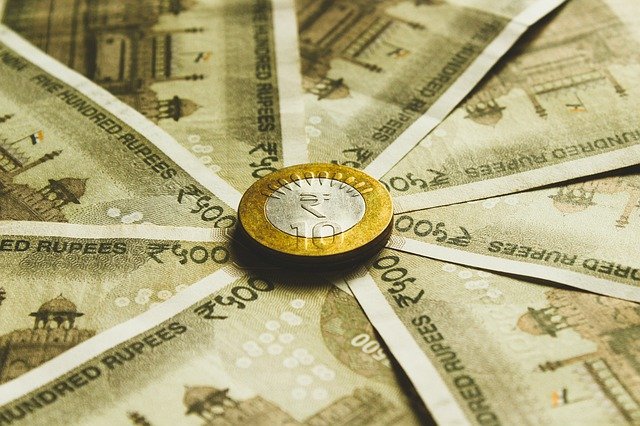
Chapter – 05
MONEY MADNESS
D.H. Lawrence
Comprehension
I. 1) How do people feel when they give
a) one pound?
Ans: When people give one pound they feel a wrench of pain.
b) ten pounds?
Ans: When people give ten pounds they experience a trembling movement caused by fear.
2) “Money has got us down” could mean a) it has ruined us. b) it has made us tremulous. c) it has made us greedy. d) it has made us its slaves. Ans: d) It has made us its slaves.
3) How are people, without money, usually treated? Ans: People without money usually treated with scorn. They are made to eat dirt which means made to acknowledge analysis and fault without grumbling.
4) What things should be made available free of cost to all the people in the world? Ans: The things should be made available free of cost to all the people in the world are bread, shelter and fire.
5) The speaker is frightened of
a) having no money.
b) money madness.
c) eating dirt.
Ans: b) money madness
6) What will happen if we do not regain our sanity about money?
Ans: We will end up killing one another if we do not regain our sanity about money.
1) How does money trigger fear in an individual?
Ans: Money triggers fear in an individual the way that an individual gets decided by the cash he has causes him to feel useless when he has no cash. Moreover, however he may be given some bread to keep himself alive, alongside this he is made to eat soil. He is made to grovel all that the rich man says to him. The possibility of this submissive presence among the cash frantic individuals who wouldn't stop for a second to kill each other for cash can scare a person.
2) How does an individual measure the value of another individual in terms of money?
Ans: An individual measure the value of another individual in terms of money when everybody is fixated on cash and that is the reason all different temperance of an individual are neglected on the off chance that he is appalling enough not to have riches. The main inquiry posed is how much an individual is worth. The normal answers are regarding material belongings. Regardless of whether an individual has the information and different gifts, none of that would get dealt with. That is the reason the speaker says that cash has got us down to the situation of slaves since we are largely captives of cash or captives of individuals of slaves since we are generally captives of cash or captives of individuals with cash. It has caused us to overlook our self-esteem and self-respect.

Please do not enter any spam link in comment box
CONTACT FOR ENGLISH NOTES
Copyright (c) 2020 - 2023 educsector.com All Rights Reserved.

- My presentations
Auth with social network:
Download presentation
We think you have liked this presentation. If you wish to download it, please recommend it to your friends in any social system. Share buttons are a little bit lower. Thank you!
Presentation is loading. Please wait.
Money Madness WebQuest Anne Bowling - Felida Elementary School - Vancouver, Washington Process Evaluation Resources Conclusion Task Introduction Welcome.
Published by Antony McDonald Modified over 7 years ago
Similar presentations
Presentation on theme: "Money Madness WebQuest Anne Bowling - Felida Elementary School - Vancouver, Washington Process Evaluation Resources Conclusion Task Introduction Welcome."— Presentation transcript:

Youre on a Quest for Money!!! Webquest made by: Rachel Yohannes & Denise Hingre Introduction Tasks Process Evaluation Resources ConclusionIntroductionTasksProcessEvaluationResourcesConclusion.

By: Samantha Doyle Over the past few weeks, you have been learning all about money. You have learned all about the different types of coins and how to.

Introduction What Are the Parts of Speech? HELP! Sara can’t remember what the parts of speech are. Can you help Sara by finding out what they are and.

Your Rights and Responsibilities

Canadian Coins: Combine and Order Numbers to 100.

Money Coin Game By Joe Hart Click here to begin Click here to enter your name.

USING MONEY: COUNTING, ADDING AND SUBTRACTING COUNTING MONEY AND USING IT TO ADD AND SUBTRACT.

Fun with Numbers A Kindergarten Mathematics Web Quest.

Open an internet browser such as internet explorer.

Lesson 7.11 One Dollar.

What is your strategy for counting money?

Introduction Process Task Evaluation Teacher Page Teacher Page Teacher Page Teacher Page A WebQuest designed for Kindergarten students for Kindergarten.

KINDERGARTEN WEBQUEST Developed by Rachael VickRachael Vick Panter Elementary Table of Contents.

By Annette Birkhead First Grade IntroductionTaskInvestigationEvaluationMoney BookConclusion.

2nd grade Math Lesson 2.MD.8. Solve word problems involving dollar bills, quarters, dimes, nickels, and pennies, using $ and ¢ symbols appropriately.

3nd Grade Mathematics Ms. Coleman

Money Introduction Lesson Quiz Introduction Basic information In order to begin this lesson you need to know a few things. One dollar bills=1 Five.

Written by : Maria Gonzalez

I wonder who has more money…. 1 dollar, 3 nickels, 5 dimes 6 dimes, 3 pennies, 5 quarters 8 pennies, 6 nickels, 3 dimes 2 half dollars, 5 pennies, 8 nickels.

Welcome to the Money Review! First, you will watch a short video about counting coins. Then, you will do some practice on your own. When you finish the.
About project
© 2024 SlidePlayer.com Inc. All rights reserved.
Money Madness! | Presentation by shyanne_rae
Toto, we're not in kansas anymore....
A server error occured and unexplained things are happening around us.
- emaze for Business
- emaze for Education
- Presentation
- Photo Album
- Digital Card
- this one opens the old contactus popup which no longer works
- Get Inspired

- Learning Management System

Welcome to…….. UW Oshkosh Money Madness
Oct 12, 2014
620 likes | 770 Views
Welcome to…….. UW Oshkosh Money Madness. The Financial Aid Game for Winners!. Let’s Get Started!. THE MONEY GAME CONSISTS OF:. 3 Ten-Minute Presentations. Followed by 3 Question and Answer Rounds.
Share Presentation
- financial aid
- student loan
- student loans
- student loan debt
- financial aid office hint

Presentation Transcript
Welcome to……..UW Oshkosh Money Madness The Financial Aid Game for Winners!
Let’s Get Started! THE MONEY GAME CONSISTS OF: • 3 Ten-Minute Presentations • Followed by 3 Question and Answer Rounds • Captains will select2 Players from their teams to face off in each Question and Answer Round HIGHEST TOTAL POINTS WINS GAME
Rules • Team captains can quickly substitute players between questions during the Question and Answer Rounds • Answering a question before answers are shown earns you 20 bonus points! • Technical – Arguing Call – Lose 20 Points
FIRST Topic: College Financial Aid Worried about College Costs? Let’s learn about Financial Aid and the UW Oshkosh Financial Aid Office.
Financial Aid 101 • Financial aid basics • Each year while you are in college, your first step is to complete the Free Application for Federal Student Aid, or your Renewal Free Application for Federal Student Aid, also known as the FAFSA • The results of the FAFSA are sent to the UW Oshkosh Financial Aid Office and they use the information to determine your financial aid package • Cost of attendance (COA) includes Tuition, Fees Room & Board, Books, Supplies and Transportation. • Stop in the Financial Aid Office on campus with your questions!
Determining Your Need for Financial Aid • The FAFSA determines your family's expected family contribution (EFC). • COA - EFC = Your Need • Your need determines how much and what type of financial aid you are eligible for. • You are considered for grants, scholarships, loans and work-study. • It doesn’t matter what your family income is, almost every student is eligible for a Federal Student Loan! • Stop in the Financial Aid Office on campus with your questions!
Sources of Financial Aid Include: • Federal • State • Institutional • Community • Employer of family • Private sources • Scholarships searches[scholarships can come from federal, state, institutional, etc. sources too.]
Paying for College • Look for free money – apply for scholarships and grants • Then consider other options for financial aid: • Work-Study • Student Education Loans (federal and private) • When borrowing loans that will be paid off after graduation. KNOW the “Real costs of school” • UWOSH.GradReady.com to monitor your student loans
Shot Clock Time • Captain selects two players from his/her team to compete • Captain can substitute players between questions • The first person to raise their hand gets to answer. NO HELP FROM THE TEAM MEMBERS SITTING IN THE AUDIENCE!!
Shot Clock Round 1
Question 120 points The Cost of Attendance (COA) includes…
Your answer is? A. Tuition, Movie Tickets and Pizza Hut Express B. Tuition, Fees, Room and Board C. Rent, Clothes and Reeve food court D. Tuition, Credit Cards and MiTaza
Question 230 points A family’s anticipated financial commitment toward college education is known as……
Your answer is? A.UWO B. EFT C. ACH D. EFC
Question 340 points A typical financial aid package consists of:
Your answer is? A. WORK-STUDY ONLY B. STAFFORD LOAN, CAR LOAN, BOAT LOAN C. GRANTS, SCHOLARSHIPS, LOANS, WORK-STUDY D. FEIGNING INJURY ON A COLLEGE CAMPUS
Question 435 points The form that families complete to determine financial need is called:
Your answer is? A. FAFSA B. FISAP C.DADSA D. SALSA
Question 550 points How many UWO students get financial aid? (Percentage)
Your answer is? A. 50% B.70% C.30% D. ALL
Question 660 points What UWO program can help you monitor your loan indebtedness and get your finances in shape?
Your answer is? A. GradReady B.GradReady C.GradReady D. All of the above
Second Topic: Debt Management Let’s Discuss 3 important topics: Student statistics, types of student loans and credit cards.
Student Debt Is Real • So smart, so successful – so broke? • Over 70% of students have to borrow to help pay for their college education. • Don’t become a statistic! • For students ages 18-24, one-third of their income is spent on debt • Average cost of college education at UWO is $17,000 per year • Average student loan debt at UWO is $28,720 • Average college student credit card debt is $3,200 at graduation • More 21-to-24-year-olds are declaring bankruptcy than graduating from college
Types of Education Loans • Always remember to stop by the UW Oshkosh Financial Aid Office with your questions! • Federal Student Loans – Take these first! • Federal Stafford Direct Loan Program • Federal Perkins Loan Program • Loans options to fill remaining need include: • Direct PLUS Loan for Parents or Graduate Students • Private Loan Programs: Undergraduate students often require a credit-worthy cosigner
It’s a Legal Contract! • When accepting a loan, you will sign a promissory note • Your Federal Student Loan Promissory Note is called a Master Promissory Note or MPN • All loans must be paid back • It is a legal obligation • Create a financial aid Folder on your computer to keep all of your financial aid documents in one place.
Before You Borrow • As you prepare to pay for college each year, keep the following guidelines in mind: • Explore ALL your financial aid options • If you need to borrow, borrow only what you need • Recognize that a student loan is a long-term commitment and must be paid back • Be realistic about your starting salary • Create your account at UWOSH.GradReady.com to manage your student loan debt
Credit Cards • Sure, it may seem like EASY $, but it’s not FREE! • Don’t let a free t-shirt make your fee or interest rate decision • Shop around • Plan your spending • Overuse of plastic can result in BIG trouble • Limit to one or two at most.
Credit Cards • Are NOT fast loans at the end of the month! • Are NOT to buy things you can’t afford!
Shot Clock Round 2
Question 145 points College students graduate with an average credit card debt of:
Your answer is? A. $1000 B.$2400 C.$3200 D. $3600
Question 250 points When you take out a loan…… What do you have to sign?
Your answer is? A. BASEBALL CARD B. PROMISSORY NOTE C. INVALID CONTRACT D. WRIT OF HABEUS CORPUS
Question 335 points Which of these is not a federal loan program?
Your answer is? A. STAFFORD B. PLUS C. PERKINS D. GUIDO, THE KILLER LOAN SHARK
Question 445 points Where is the financial aid office? (Hint: the oldest building on campus)
Your answer is? • SWART B.REEVE UNION C.SAGE D.DEMPSEY
Final Topic: Budgeting and Your Credit Let’s talk about: Budget Basics, Your Credit Score and your Earning Power
Budget Basics • Develop your budget or financial plan • Know your income and expenses • Organize your bills and payments • Identify wants vs. needs(find ways to cut costs) • Make smart choices • Pay yourself first – even $5 adds up • Save money by packing snacks or making coffee at home.
Be a Millionaire • How easy is it to spend $10 a day at McDonalds, vending machines? • Saving just $5 a day and investing it well means, $150 a month, $2,000 a year and by age 55 you’d have $1 million dollars…..wow! The power of saving!!!
The Right Tools For the Job • Find a bank. One that works for YOU! • Start a Savings account • Manage your Checking account • Manage your ATM/debit card • Manage one Credit card with a low limit, for example start with a $500 limit …(yes, one is plenty) • Having good credit will impact your ability to borrow money for a car, college and a future home.
Your Credit Score: Think of it as your GPA for how you manage your money! • FICO Score is also known as your Credit Score • Your individual FICO Score: • Analyzes your credit history • Generates a number from 300 to 850 (the higher the better!) • High score means your are a ‘good’ credit risk so you get great financial opportunities such as: • Borrowing money at lower interest rates • Renting or owning a home • Potential employers, insurance companies may also review your credit score!
Your Credit Score: Think of it as your GPA for how you manage your money! • What impacts this score? • Paying your bills on time and in full • Minimum number of credit cards • Keeping your total debt below your income • No Joke – this score counts!
Your Earning Power – Real Life Example What’s the real bottom line?$40,000 a year = $2,000 take-home a month Now, how does this look?Rent/Utilities $780Food/groceries $450Transportation $400Student Loan Payment $182Minimum Credit card payment $100 Oops!! $88 left for the month? (less than $3/day)
Shot Clock Round 3
Question 130 points What is the most important finance survival tool?
Your answer is? A. A high interest credit card B. Mom and dad’s phone number C. Having a budget/financial plan
Question 240 points In the 2013 film The Great Gatsby,the part of Gatsby is played by this actor:
Your answer is? A. TOM CRUISE B. GEORGE CLOONEY C.LEONARDO DICAPRIO D.MATT DAMON
- More by User
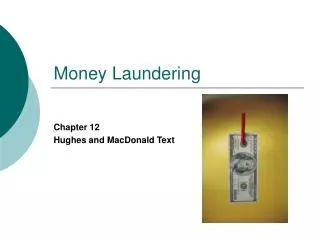
Money Laundering
Money Laundering. Chapter 12 Hughes and MacDonald Text. Questions You will Want to Be able to Answer. What is money laundering? What motivates people to launder money? What basic process is followed to launder money?
1.51k views • 27 slides

A History of Money!
A History of Money!. Banking & Credit Mr. Yates. What did we do before money?. In the beginning, people bartered . Barter is the exchange of a good or service for another good or service bag of rice for a bag of beans. . Barter. Commodity Money.
7.72k views • 27 slides
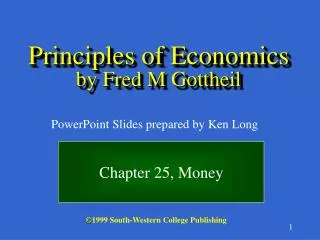

Principles of Economics by Fred M Gottheil
Principles of Economics by Fred M Gottheil. PowerPoint Slides prepared by Ken Long. Chapter 25, Money. © 1999 South-Western College Publishing. What is Money?. Note that money is a man-made invention: before money, people used barter. What is Barter?.
948 views • 60 slides

Prevention of Money Laundering and Terrorist Financing
Prevention of Money Laundering and Terrorist Financing. 22 June 2005. Outline of our Legal Seminar. What is Money Laundering and Terrorist Financing The Legislation on money laundering in Hong Kong Basic policies to combat money laundering and terrorist financing
1.26k views • 77 slides
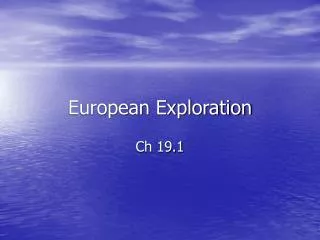
European Exploration
European Exploration. Ch 19.1. What exploration had already occurred?. Europeans explored during the Crusades beginning in 1100. Marco Polo reached Kublai Khan and the Chinese empire in 1275. Money! Money! Money! . The main reason for new exploration was to seek for new sources of wealth.
868 views • 70 slides

Chapter 6 - Time Value of Money
Chapter 6 - Time Value of Money. Time Value of Money. A sum of money in hand today is worth more than the same sum promised with certainty in the future. Think in terms of money in the bank
2.22k views • 70 slides
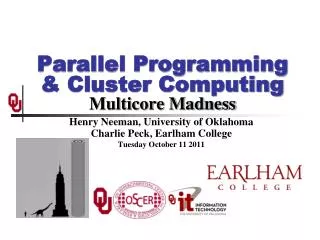
Parallel Programming & Cluster Computing Multicore Madness
Parallel Programming & Cluster Computing Multicore Madness. Henry Neeman, University of Oklahoma Charlie Peck, Earlham College Tuesday October 11 2011. Outline. The March of Progress Multicore/Many-core Basics Software Strategies for Multicore/Many-core
914 views • 74 slides
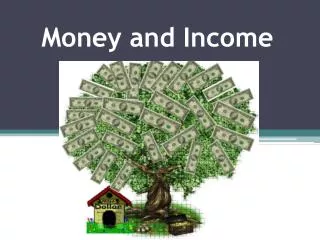
Money and Income
Money and Income. Money. Students will have an understanding of how money has evolved – the history Students will have a knowledge of other countries currencies and understand that each country has their own currency Students will have understanding of the money of NZ. Do Now – 3 mins.
1.27k views • 72 slides

PB202 MACROECONOMICS
PB202 MACROECONOMICS. CHAPTER 5 MONEY AND MONETARY POLICY. Chapter Summary. Arrow Process. Why use graphics from PowerPointing.com?. Definition Disadvantages of Barter System Characteristics of money Functions of money Types of money. Definition Three types (M1, M2, M3)
1.29k views • 78 slides
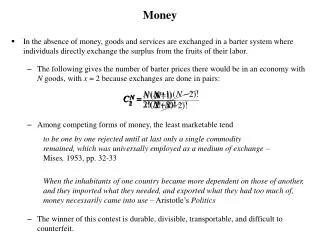
Money. In the absence of money, goods and services are exchanged in a barter system where individuals directly exchange the surplus from the fruits of their labor.
864 views • 71 slides
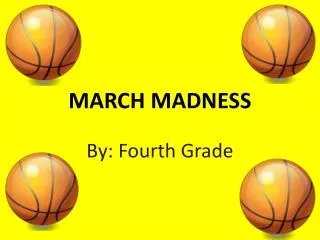
MARCH MADNESS
MARCH MADNESS. By: Fourth Grade. MARCH MADNESS. Ashlyn &Sarah. SCHOOL Bishop Garrigan. MASCOT. Golden Bears. BASKETBALL-. RECORD:18 W-7 L CLASS : Boys 1A. Other information. Danz Squad . MARCH MADNESS. Jed Knobloch Mason Studer. SCHOOL: Dallas Center-Grimes. MASCOT.
861 views • 51 slides
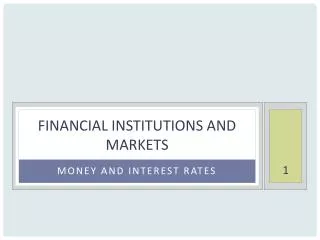
Financial Institutions and Markets
Financial Institutions and Markets. Money and interest rates. Outline of contents. A recap of topic 04 Defining money Measuring the amount of money that exists Commercial banks and money creation What are interest rates? The loanable funds theory of interest rate determination
1.27k views • 96 slides

Money. LECTURE TOPICS. What Is Money? The Monetary System The Federal Reserve System. 11.1 WHAT IS MONEY?. Definition of M oney Money Any commodity or token that is generally accepted as a means of payment. Any Commodity or Token Something that can be recognized
1.06k views • 94 slides

Money Growth and Inflation
22. Money Growth and Inflation. E conomics. E S S E N T I A L S O F. N. Gregory Mankiw. Premium PowerPoint Slides by Ron Cronovich. In this chapter, look for the answers to these questions:. How does the money supply affect inflation and nominal interest rates?
2.83k views • 52 slides

Chapter 7 The Asset Market, Money, and Prices
Chapter 7 The Asset Market, Money, and Prices. Chapter Outline. What Is Money? Portfolio Allocation and the Demand for Assets The Demand for Money Asset Market Equilibrium Money Growth and Inflation. What Is Money?. Money: assets that are widely used and accepted as payment
1.32k views • 75 slides

Letter To God
Lencho’s crop was destroyed by heavy rain.so he turned to God for help. He wrote to God a letter asking him to send him money. He received a letter from God along with some money. Who actually sent the money? What did Lencho do then? Let us read the story…. Letter To God. G.L Fuentes.
51.38k views • 23 slides
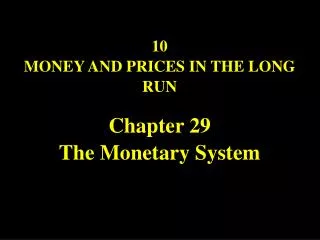
10 MONEY AND PRICES IN THE LONG RUN Chapter 29 The Monetary System
10 MONEY AND PRICES IN THE LONG RUN Chapter 29 The Monetary System. 29.1 The Meaning of Money. Money is the set of assets in an economy that people regularly use to buy goods and services from other people. 29.1.1 The Functions of Money. Money has three functions in the economy:
1.13k views • 85 slides
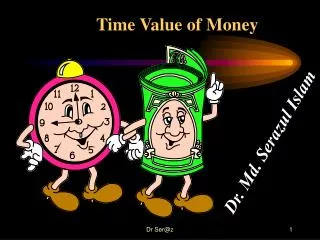
Time Value of Money
Time Value of Money. Dr. Md. Serazul Islam. The Time Value of Money. Compounding and Discounting Single Sums. Today. Future. We know that receiving $1 today is worth more than $1 in the future. This is due to opportunity costs .
1.01k views • 78 slides

What is Money?
What is Money?. "When it's a question of money, everybody is of the same religion." Voltaire. Functions of Money. Store of Value Medium of Exchange Unit of Account. Various Types of Money. Commodity Money Convertible Paper Fiat Money Demand Deposits Electronic Money. Commodity Money.
1.27k views • 46 slides

Money and Banking, the Fed,
Money and Banking, the Fed,. Money Creation, & Monetary Policy. Monetary Policy 1. Discount Rate 2. Reserve Ratio 3. Bonds. Ben Bernanke. There is $800 billion in currency [notes & coins]. [2/3 is overseas]. Money and Banking. Money = paper notes + coins + Demand Deposits
876 views • 62 slides
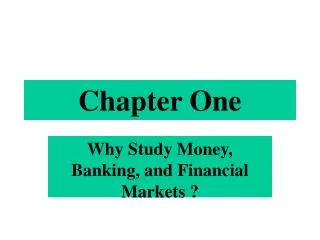
Chapter One
Chapter One. Why Study Money, Banking, and Financial Markets ?. We study money because :. 1. Its growth rate may be a driving force behind inflation . 2. Money plays an important role in generating the business cycle i.e. upward and downward
3.83k views • 371 slides
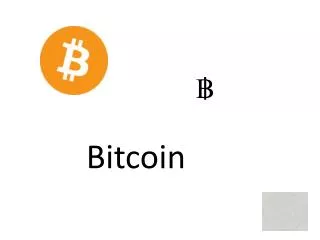
Bitcoin. ฿. Bitcoin Wallet. Bitcoin Wallet - receive. Advertising for Bitcoins . Bitcoin Wallet - send. History of Money. Barter. Goods *BECOME* Money. Acceptable Durable Portable Scarce Divisible Recognizable. Peacefully and voluntarily, markets choose money.
1.13k views • 65 slides
Got any suggestions?
We want to hear from you! Send us a message and help improve Slidesgo
Top searches
Trending searches

memorial day
12 templates

21 templates

summer vacation
23 templates

17 templates

20 templates

11 templates
Money Presentation templates
Money, money, money, must be funny, in slidesgo’s world we know that money is not the key to happiness, but we are sure that these designs about it will make you feel very happy (and fortunate) look at these templates, full of coins, banknotes, credit cards… (as design concepts, of course…)..

Premium template
Unlock this template and gain unlimited access
How to Plan and Budget for a Family Vacation
Download the "How to Plan and Budget for a Family Vacation" presentation for PowerPoint or Google Slides and prepare to receive useful information. Even though teachers are responsible for disseminating knowledge to their students, they also embarked on a learning journey since the day they decided to dedicate themselves to...

Economics Thesis
If numbers, exchange rates, money and trading are your forte, odds are you’re already working on an economics thesis for your master’s degree. Defending your dissertation is the last step and the most difficult one, but Slidesgo can help you. Here’s our new free presentation template with a focus on...

Cashback App Pitch Deck
Are you familiar with the concept of cashback? Are you developing a mobile app for people to receive "cash back" on their purchases? We are all very happy to read messages like "this item is 15% off" or "with this purchase you will receive 10% of the price in the...
Falling Money Background Animation
Money calls money, so, let's try it with this exclusive PowerPoint template, where we have added backgrounds with falling money animations. The green background is reminiscent of the color of banknotes, and the illustrations add the final touch to this multipurpose presentation that you can adapt to talk about different...

US National Dollar Day Minitheme
The dollar is the name of the official currency of various countries, dependencies and regions. The US dollar is the most widely circulated money in the world. August 8 marks its national day in the United States, and we wanted to be part of this important celebration with this complete...

Bookkeeping Dashboard
Download the "Bookkeeping Dashboard" presentation for PowerPoint or Google Slides. The world of business encompasses a lot of things! From reports to customer profiles, from brainstorming sessions to sales—there's always something to do or something to analyze. This customizable design, available for Google Slides and PowerPoint, is what you were...

Savings Calculator App Pitch Deck
Download the Savings Calculator App Pitch Deck presentation for PowerPoint or Google Slides. Whether you're an entrepreneur looking for funding or a sales professional trying to close a deal, a great pitch deck can be the difference-maker that sets you apart from the competition. Let your talent shine out thanks...
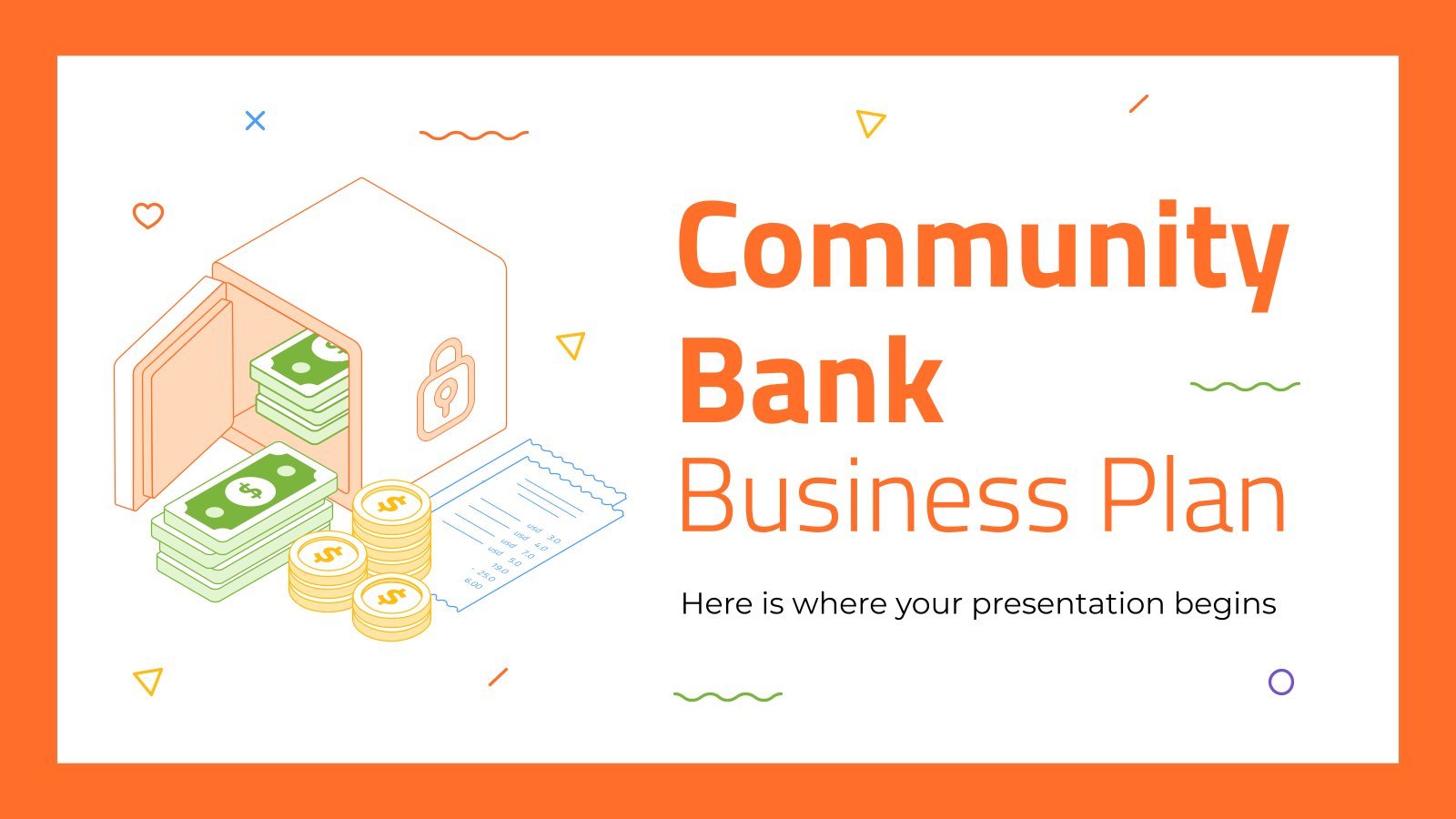
Community Bank Business Plan
Register all your liabilities, earnings, and balance your finances out with this modern template for banks! It includes all the resources needed for a good business plan: graphs, tables, charts, diagrams… the information must be as clear as possible! The modern design combining simple geometrical forms and fun orange tones...

Artificial Intelligence in Finance Project Proposal
Download the "Artificial Intelligence in Finance Project Proposal" presentation for PowerPoint or Google Slides. A well-crafted proposal can be the key factor in determining the success of your project. It's an opportunity to showcase your ideas, objectives, and plans in a clear and concise manner, and to convince others to...

Economic Analysis for Business Decisions
Making decisions is an everyday thing for any kind of business. Of course, one of the main factors (if not the main one) in that decision making is the economic viability. After all, everyone works to earn money! Are you an expert on economic analyses? "Cost-effectiveness" and "cost-benefit" are concepts...
French Economy Newsletter
In need of help putting together an economy newsletter in French? If so, this is the template for you! Its beautiful slides combine red over a white background for a stylish and friendly feel, and its many illustrations let you touch on a variety of subjects while always being entertaining....

Cost Comparison Poject Proposal
Download the Cost Comparison Poject Proposal presentation for PowerPoint or Google Slides. A well-crafted proposal can be the key factor in determining the success of your project. It's an opportunity to showcase your ideas, objectives, and plans in a clear and concise manner, and to convince others to invest their...

Score Financial Projections Meeting
Download the Score Financial Projections Meeting presentation for PowerPoint or Google Slides. Gone are the days of dreary, unproductive meetings. Check out this sophisticated solution that offers you an innovative approach to planning and implementing meetings! Detailed yet simplified, this template ensures everyone is on the same page, contributing to...

Fiscal Annual Planning Project Proposal
Download the Fiscal Annual Planning Project Proposal presentation for PowerPoint or Google Slides. A well-crafted proposal can be the key factor in determining the success of your project. It's an opportunity to showcase your ideas, objectives, and plans in a clear and concise manner, and to convince others to invest...

Design Inspiration Business Plan
Download the "Design Inspiration Business Plan" presentation for PowerPoint or Google Slides. Conveying your business plan accurately and effectively is the cornerstone of any successful venture. This template allows you to pinpoint essential elements of your operation while your audience will appreciate the clear and concise presentation, eliminating any potential...

Business Cost Analysis
When it comes to analyzing your business costs, you want a professional presentation that gets straight to the point. That's where this template for Google Slides and PowerPoint comes in. With its clean and simple design in cream tones, this template will help you present your findings in a clear...

Paraguayan Economy Thesis Defense
Paraguay is a South American country has a unique history and diverse economic makeup that can provide interesting topics for research. If you've majored in economy and decided to do a thesis on the Paraguayan economy, you'll need to talk about topics such as industrialization, natural resources, trade or economic...

Tax Considerations in your Business
Download the "name" presentation for PowerPoint or Google Slides. The world of business encompasses a lot of things! From reports to customer profiles, from brainstorming sessions to sales—there's always something to do or something to analyze. This customizable design, available for Google Slides and PowerPoint, is what you were looking...
- Page 1 of 30
New! Make quick presentations with AI
Slidesgo AI presentation maker puts the power of design and creativity in your hands, so you can effortlessly craft stunning slideshows in minutes.

Register for free and start editing online
- Cast & crew
- User reviews
Money Madness

A murderous bank robber on the run from the law hides out in a small town, where he gets a job as a cab driver. He meets a young girl who is caring for her ill but wealthy aunt. He courts he... Read all A murderous bank robber on the run from the law hides out in a small town, where he gets a job as a cab driver. He meets a young girl who is caring for her ill but wealthy aunt. He courts her and they eventually marry. She soon discovers exactly who he is, and finds herself enmes... Read all A murderous bank robber on the run from the law hides out in a small town, where he gets a job as a cab driver. He meets a young girl who is caring for her ill but wealthy aunt. He courts her and they eventually marry. She soon discovers exactly who he is, and finds herself enmeshed in a scheme involving murder and loot from a bank robbery.
- Sam Newfield
- Hugh Beaumont
- Frances Rafferty
- Harlan Warde
- 14 User reviews
- 5 Critic reviews

- Steve Clark

- Julie Saunders

- Donald Harper

- Mrs. Ferguson
- Jack Rogers

- Martha - Waitress
- (uncredited)
- Photo Shop Assistant

- Malt Shop Customer

- Taxi Company Boss

- Vance - Reporter

- All cast & crew
- Production, box office & more at IMDbPro
More like this

Did you know
- Trivia The failure of the original copyright holder to renew the film's copyright resulted in it falling into public domain, meaning that virtually anyone could duplicate and sell a VHS/DVD copy of the film. Therefore, many of the versions of this film available on the market are either severely (and usually badly) edited and/or of extremely poor quality, having been duped from second- or third-generation (or more) copies of the film.
Steve Clark : Listen, Julie. Get this straight. What I have I keep. That goes for the money, and it goes for you.
User reviews 14
- planktonrules
- Oct 3, 2016
- April 15, 1948 (United States)
- United States
- The Easy Way
- Sutherland Studios, Los Angeles, California, USA
- Sigmund Neufeld Productions
- See more company credits at IMDbPro
Technical specs
- Runtime 1 hour 13 minutes
- Black and White
Related news
Contribute to this page.

- See more gaps
- Learn more about contributing
More to explore

Recently viewed
Mobile Menu Overlay
The White House 1600 Pennsylvania Ave NW Washington, DC 20500
President Biden Announces Recipients of the Presidential Medal of Freedom
Today, President Biden named nineteen recipients of the Presidential Medal of Freedom. The Presidential Medal of Freedom is the Nation’s highest civilian honor, presented to individuals who have made exemplary contributions to the prosperity, values, or security of the United States, world peace, or other significant societal, public or private endeavors. President Biden often says there is nothing beyond our capacity when we act together. These nineteen Americans built teams, coalitions, movements, organizations, and businesses that shaped America for the better. They are the pinnacle of leadership in their fields. They consistently demonstrated over their careers the power of community, hard work, and service. The awards will be presented at the White House on May 3, 2024. The following individuals will be awarded the Presidential Medal of Freedom: Michael R. Bloomberg Mayor Michael Bloomberg is an entrepreneur, philanthropist, and three-term mayor. He revolutionized the financial information industry and transformed New York City’s education, environment, public health, and the arts. Gregory J. Boyle Father Greg Boyle is a Jesuit Catholic priest who is the founder and director of Homeboy Industries, the world’s largest gang-intervention and rehabilitation program. He has helped thousands of Angelenos turn their lives around. James E. Clyburn Representative Jim Clyburn is the former Assistant Democratic Leader and Majority Whip in the United States House of Representatives. Through three decades in the House, Representative Clyburn has transformed the lives of millions of Americans and created a freer country. Elizabeth Dole Senator Elizabeth Dole has served her country as a trailblazing United States Senator, Secretary of Transportation, Secretary of Labor, and President of the American Red Cross. She leads by example through her Foundation’s support for military caregivers and their families. Phil Donahue Phil Donahue is a journalist and television pioneer who pioneered the daytime issue-oriented television talk show. Donahue was the first daytime talk show to feature audience participation and one of the most influential televisions programs of its time. Medgar Wiley Evers (posthumous) Medgar Evers (d. 1963) fought for his country in World War II and returned home to lead the fight against segregation in Mississippi. After he was murdered at his home at age 37, his wife Myrlie continued the fight to seek justice and equality in his name. Al Gore Al Gore is a former Vice President, United States Senator, and member of the House of Representatives. After winning the popular vote, he accepted the outcome of a disputed presidential election for the sake of our unity. He was awarded the Nobel Peace Prize jointly with the Intergovernmental Panel on Climate Change for his bold action on climate change. Clarence B. Jones Clarence B. Jones is a renowned civil rights activist and lawyer who helped draft Dr. Martin Luther King, Jr’s “I Have a Dream” speech. Jones was instrumental in preserving Dr. King’s legacy and remains an outspoken force against hate. John Forbes Kerry Secretary John Kerry is a former Secretary of State, United States Senator, and the first Special Presidential Envoy for Climate. His bravery in combat during the Vietnam War earned him the Silver Star and Bronze Star, and history will remember his public service career that has spanned seven decades. Frank R. Lautenberg (posthumous) Senator Frank Lautenberg (d. 2013) was a five-term United States Senator and New Jersey’s longest-serving Senator. He is remembered for his critical work on environmental protection and consumer safety across a number of fields. Kathleen Genevieve Ledecky Katie Ledecky is the most decorated female swimmer in history. An athletic prodigy, she has won seven Olympic gold medals and twenty-one world championship gold medals so far. She will continue to compete for the Nation who watches her in awe. Opal Lee Opal Lee is an educator and activist known for her efforts to make Juneteenth a federally recognized holiday. More than 150 years after that day in Texas, she joined President Biden to officially make Juneteenth a national holiday in 2021. Ellen Ochoa Ellen Ochoa is the first Hispanic woman in space and the second female Director of NASA’s renowned Johnson Space Center. Dr. Ochoa has flown in space four times, logged nearly 1,000 hours in orbit, and continues to inspire young generations of scientists. Nancy D’Alesandro Pelosi Nancy Pelosi served as the 52nd Speaker of the House and has represented San Francisco in Congress for more than 36 years. A staunch defender of democracy, she has shaped legislative agendas and Democratic priorities for decades. Jane Rigby Jane Rigby, an astronomer who grew up in Delaware, is the chief scientist of the world’s most powerful telescope. A prolific researcher, Dr. Rigby embodies the American spirit of adventure and wonder. Teresa Romero Teresa Romero is the president of the United Farm Workers and the first Latina to become president of a national union in the United States. She has secured key victories to improve the lives of the workers who feed and fuel our Nation. Judy Shepard Judy Shepard is the co-founder of the Matthew Shephard Foundation, an organization created in honor of her son who was murdered in one of the nation’s most notorious anti-gay hate crimes. Her work has driven tremendous progress in our fight to give hate no safe harbor. James Francis Thorpe (posthumous) Jim Thorpe (d. 1953) was the first Native American to win an Olympic gold medal. The country’s original multi-sport superstar, he went on to play professional football, baseball, and basketball while breaking down barriers on and off the field. Michelle Yeoh Michelle Yeoh is an actress known for her groundbreaking work in a number of blockbusters over four decades. Recently, she became the first Asian to win the Academy Award for Best Actress. Yeoh continues to shatter stereotypes and enrich American culture.
Stay Connected
We'll be in touch with the latest information on how President Biden and his administration are working for the American people, as well as ways you can get involved and help our country build back better.
Opt in to send and receive text messages from President Biden.

IMAGES
VIDEO
COMMENTS
9. Free Verse • Money Madness is a Free verse. • poetry that is free from limitations of regular meter or rhythm, and does not rhyme with fixed forms. • Walt Whitman is known as the father of free verse English poetry. • free verse was also attractive to poets simply because it lacked the restrictions and constraints imposed on poetry by meter and rhyme, and therefore left it to the ...
Money Madness. Money Madness. Gold: You did it! You're a Millionaire (2% of the population). Statistically speaking, you represent a portion of society that follows a financial game plan, avoids debt, invest early in life, and wisely uses their resources. 610 views • 7 slides
Summary of Money Madness. Money Madness is written by D.H. Lawrence. In this poem, the poet exposes the craziness of money-hungry humans. The poet condemns the madness for money, claiming that it has resulted in the loss of life's values. D.H.Lawrence's poems, such as 'Snake' and 'Mosquito', are primarily an examination of ...
The poem "Money Madness" begins with an ironic statement. Lawrence describes money as a vast and collective ailment of mankind. It is not limited to an individual. Rather, it has become gout in the legs of humanity. In the following lines, the speaker says that this madness differs from person to person.
Money Madness. Gold: You did it! You're a Millionaire (2% of the population) • Statistically speaking, you represent a portion of society that follows a financial game plan, avoids debt, invest early in life, and wisely uses their resources.. Silver: Debt Free & Living Large (10% of the population) • You've paid for your college education, your car, and your house.
Presentation on theme: "Money Madness. Paraphrasing … is a testimony to the ambivalences and conflicts generated by money in our society. … shows clearly that there are two conflicting."— Presentation transcript:
Back to: Karnataka Board Class 11th English Guide and Notes. The poem Money Madness is a stinging exposition of the modern consumerist world that is based on material wealth and money. People today are so invested in the race to aggregate money that they are willing to sacrifice their morals and even sanity. The poet labels money and the greed ...
Money turns man insane.Read the poem and note how the poet pleads for a society without money. The Text. Money is our madness, our vast collective madness. And of course, if the multitude is mad. the individual carries his own grain of insanity around with him. I doubt if any man living hands out a pound note without a pang;
In summary, "Money Madness" by D.H. Lawrence is a powerful and cautionary tale that exposes the destructive power of materialism. Through the transformation of the protagonist, Paul, the story highlights the pitfalls of equating personal worth with financial success. Lawrence's narrative serves as a reminder to prioritize genuine human ...
This video is a read aloud of the story, Money Madness by David Adler and illustrated by Edward Miller. The story introduces children to the origin of money ...
a) having no money. b) money madness. c) eating dirt. Ans: b) money madness. 6) What will happen if we do not regain our sanity about money? Ans: We will end up killing one another if we do not regain our sanity about money. II. 1) How does money trigger fear in an individual? Ans: Money triggers fear in an individual the way that an individual ...
2 Money Madness WebQuest Anne Bowling - Felida Elementary School - Vancouver, Washington Process Evaluation Resources Conclusion Task Introduction Task Follow the steps in the Process tab to complete your assignments about money. You will need to read carefully and follow the instructions for each assignment. You will listen to lessons, play games, and have fun learning about money.Process
Answer: (c) regaining sanity or killing one another. Question 23. The fear that the poet speaks of, in the poem 'Money Madness' is. (a) money has a cruel fearful power among men. (b) the collective money madness of mankind. (c) having to eat dirt if he has no money. (d) all of the above.
Money Madness is a 1948 film noir mystery film directed by Sam Newfield starring Hugh Beaumont and Frances Rafferty. Plot. Steve Clark (Hugh Beaumont) is on a Los Angeles-bound bus and gets off in a small town en route. In his suitcase he has been carrying loot from a bank robbery; he stashes it in a safety deposit box.
Five Dollar Bill $5 One Dollar Bill $1 MONEY MADNESS! 2nd Grade A nickel is worth 5¢ Watch this video! Place Value 45¢ $1.25 3¢ Helpful Hints Helpful Hints These place values are for the amount of cents you have When to ADD in a word problem: "How much do you have left?" ... A step-by-step guide to craft a winning sales presentation outline ...
money madness!penny = 1 cent nickel = 5 cents dime= 10 cents quarter= 25 cents let's sing together!
UW Oshkosh Money Madness. The Financial Aid Game for Winners!. Let's Get Started!. THE MONEY GAME CONSISTS OF:. 3 Ten-Minute Presentations. Followed by 3 Question and Answer Rounds. Slideshow 5442984 by fauna ... An Image/Link below is provided (as is) to download presentation Download Policy: ...
2. Crypton - Money Cryptocurrency PowerPoint Template. Use Crypton for any cyber money-related presentations. This modern and elegant P owerPoint money theme comes with a total of 45 money slides. This professional P owerPoint template money allows you to create your presentation in minutes.
brilliance and inspiration. Madness is, virtually by definition, characterized by anomalous behavior, affect, and beliefs in any given context, and yet—partly because of this, and partly in spite of it— madness can be the most telling index of what a given society regards as normal or idealises as paradigm of functionality and health.
Money Presentation templates. Money, money, money, must be funny, in Slidesgo's world! We know that money is not the key to happiness, but we are sure that these designs about it will make you feel very happy (and fortunate)! Look at these templates, full of coins, banknotes, credit cards… (as design concepts, of course…).
Download your presentation as a PowerPoint template or use it online as a Google Slides theme. 100% free, no registration or download limits. Get these money templates to create visually stunning presentations that make your message count. No Download Limits Free for Any Use No Signups.
Money Madness: Directed by Sam Newfield. With Hugh Beaumont, Frances Rafferty, Harlan Warde, Cecil Weston. A murderous bank robber on the run from the law hides out in a small town, where he gets a job as a cab driver. He meets a young girl who is caring for her ill but wealthy aunt. He courts her and they eventually marry. She soon discovers exactly who he is, and finds herself enmeshed in a ...
With our money PowerPoint themes, you can create engaging and persuasive presentations that will help you stand out from the competition. These well-designed PowerPoint presentation background styles can help you visualize your plans and track your progress. This collection of PPT themes contains a range of options that will enhance your presentation to discuss various business development ...
The awards will be presented at the White House on May 3, 2024. The following individuals will be awarded the Presidential Medal of Freedom: Michael R. Bloomberg. Mayor Michael Bloomberg is an ...